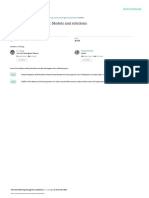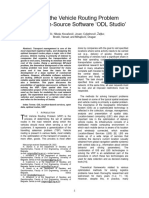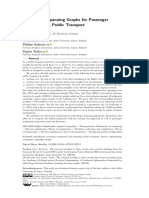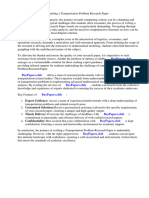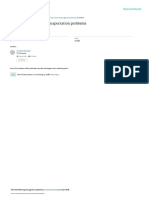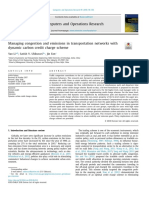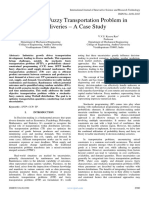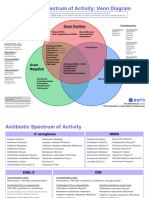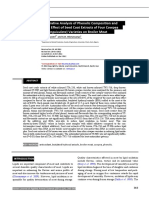Professional Documents
Culture Documents
The Vogel Approximation and North West Corner Transportation Models For Optimal Cost Distribution of Dangote Cement
Original Title
Copyright
Available Formats
Share this document
Did you find this document useful?
Is this content inappropriate?
Report this DocumentCopyright:
Available Formats
The Vogel Approximation and North West Corner Transportation Models For Optimal Cost Distribution of Dangote Cement
Copyright:
Available Formats
Volume 8, Issue 5, May 2023 International Journal of Innovative Science and Research Technology
ISSN No:-2456-2165
The Vogel Approximation and North West
Corner Transportation Models for Optimal
Cost Distribution of Dangote Cement
Adeniyi Samson Onanaye1 , Amanze C. Egere2, Adeniyi Oluwakoya3, Mba Obasi Odim4
Department of Mathematics and Statistics1,2, Department of Transport Management3, Department of Computer Science4
Redeemer’s University Ede, Nigeria
Abstract:- Most industrial and service organizations now putting sustainable transportation planning and policy into
include transportation logistics and management in their practice was examined in [3]. Three main issues: forecast-
business decision making process. The cost of led vs vision-led planning, congestion relief, and public
transportation and the distribution of goods from acceptance were considered. The study concluded that the
manufacturing facilities to depots raise transportation goal of lowering car use is at odds with the ongoing
costs, which will ultimately have an impact on the selling investment in expanding road capacity and switching from
price of the product and will then directly or indirectly forecast-led planning to back casting is challenging.
affect final consumers. Several academic publications Mishera[2] asserted that the transportation issue is regarded
had proposed linear programming transportation as being of the utmost importance and has been investigated
models for transport logistics problems. Thispaper, in a number of operational and research fields. It has
models and assesses the performance of the Vogel therefore been used to simulate a variety of issues from real
Approximation and North West Corner transportation life. The transportation problem is focused on the optimal
models on the logistics of optimal distribution bags of distribution of units of a product from various points of
cement of Dangote Cement Company Plc, Nigeria, from origin to various destinations
some cement facilities, to various depots while
minimizing transportation cost. The outcome of this A. Network flow programming
study demonstrated a considerable decrease on the A model that is a particular instance of the more general
transportation cost of the distribution of the product to linear problem is referred to as a "network flow program."
various depots as well as simple distribution from plants The transportation problem, assignment problem, maximum
to depots. The Vogel Approximation model showed a flow problem, pure minimum cost flow problem, and
slight improvement on distribution cost reduction by generalized minimum cost flow problem are only a few
eight thousand, three hundred naira compared to the examples of the problems that fall within the categories of
North-West Corner Rule. At the conclusion of the study, network flow programs. The model representation is
recommendations were given. substantially more compact than the general linear problem,
and many elements of real-world situations are easily
Keywords:- Vogel Approximation, North West Corner, recognized, making it an essential class. We frequently
Transportation Model, Optimal Distribution, Dangote encounter unique linear programming issues with a fairly
Cement. straightforward structure, and the transportation issue
dominates this category. The study of ideal transportation
I. INTRODUCTION and resource allocation is known as transportation theory in
Planning for sustainable mobility and management of both mathematics and economics. Although Tolstoi was one
transportation are essential for manufacturing and service of the first to examine the transportation problem
provider businesses. In terms of effectiveness and theoretically in the 1920s, the problem was formalized by
environmental friendliness, a well-planned transportation the French mathematician Gaspard in 1971. For the Soviet
system has many advantages. Over the years, plant product Union's national transportation commissariat, Volume 1 of
distributions have been carried out haphazardly without the series Transportation Planning was published in 1930.
taking into account an optimal distribution pattern, which B. Transportation Model
has an impact on the cost of the commodity. A The problem is represented by the network in the Figure
transportation problem is a linear programming problem that 1. There are m sources and n destinations, each represented
involves choosing the best route to take finished product by a node. The arcs represent the routes linking the sources
from plants to different locations (depots) and moving and the destinations. Arc (𝑖, 𝑗) joining sources i to
resources from one place to another while keeping costs to a destination j carries two pieces of information: the
minimum. The objective is to minimize the cost of
transportation cost per unit, cij, and the amount shipped, 𝑥𝑖𝑗.
distribution a product from a number of sources or origins to
The amount of supply at source i is 𝑎𝑖 , and the amount of
a number of destinations [1].Transportation problem is
demand at destination j is 𝑏𝑗 .
further describedin [2]as the most important and successful
applications in the optimization), that is a special class of the
linear programming (lp) in the operation research (or).The
planners’ mental models to comprehend the difficulties in
IJISRT23MAY701 www.ijisrt.com 1364
Volume 8, Issue 5, May 2023 International Journal of Innovative Science and Research Technology
ISSN No:-2456-2165
In [2], three models of transportation problem, namely
North West Corner Method, Minimum Cost Method and
Vogel’s approximation Method, wereanalysed. The results
of the analysis show that the minimum-cost method finds a
better starting solution by concentrating on the cheapest
routes, and that the cost of transportation with Vogel's
approximation method and Minimum-cost method is less
than North-West corner method. Two new methods (based
on fuzzy linear programming formulation and classical
transportation methods) are proposed to find the fuzzy
optimal solution of unbalanced fuzzy transportation
problems by representing all the parameters as trapezoidal
fuzzy numbers in [5]. The proposed methods are easy to
understand and to apply for finding the fuzzy optimal
solution of fuzzy transportation problems occurring in real
life situations. Ebrahimnejad & Verdegay [6] presented a
network-structured transportation problem (TP) considered
Fig. 1: A network of transport model
in an uncertain environment. The main contributions of the
Essentially, a transportation problem is one that paper are fivefold: (1) they convert the formulated IFTP into
involves determining the optimal strategy to use the a deterministic classical LP problem based on ordering of
resources of m supply points to meet the needs of n demand TrIFNs using accuracy function; (2) in contrast to most
sites. While attempting to determine the optimum course of existing approaches, which provide a crisp solution, they
action, the variable cost of shipping the goods from one propose a new approach that provides an intuitionistic fuzzy
supply location to another or a comparable constraint should optimal solution; (3) in contrast to existing methods that
typically be taken into account. A transportation issue is include negative parts in the obtained intuitionistic fuzzy
deemed to be balanced if total supply and total demand are optimal solution and intuitionistic fuzzy optimal cost, we
equal. propose a new method that provides non-negative
intuitionistic fuzzy optimal solution and optimal cost; (4) we
C. Transportation tableau discuss about the advantages of the proposed method over
The costs of shipping, demand, and supply all contribute the existing methods for solving IFTPs; (5) we demonstrate
to defining the transportation dilemma (problem). Hence, the feasibility and richness of the obtained solutions in the
the relevant information can be distilled using a context of two application examples.In [7], a novel ranking
transportation tableau. The transportation tableau implicitly function is proposed to finding an optimal solution of fully
expresses the supply and demand thresholds as well as the LR-intuitionistic fuzzy transportation problem by using the
shipping costs between each demand and supply point. distance minimizer of two LR-IFNs. It is shown that the
Hence, Transportation Tableau is a unique, statistically- proposed ranking method for LR-intuitionistic fuzzy
based strategy to the transportation problem (problem). numbers satisfies the general axioms of ranking functions.
Further, we have applied ranking approach to solve an LR-
II. RELATED WORK intuitionistic fuzzy transportation problem in which all the
parameters (supply, cost and demand) are transformed into
An all-encompassing framework efficiency model for LR-intuitionistic fuzzy numbers. The proposed method is
moving commodities was created by [4]. It is designated for illustrated with a numerical example to show the solution
the delivery of regional less-than-truck loads. Using a semi- procedure and to demonstrate the efficiency of the proposed
Delphi process, specialists in the field provided quantitative method by comparison with some existing ranking methods
data on the size of the partial efficiencies, their dispersion, available in the literature.
and their potential for improvement. This has shown a
number of elements of road freight transportation that have In order to solve transportation issues, [8]divided the
significant prospects for efficiency growth. The findings of original issue into a number of two-dimensional
this study demonstrate that a whole spectrum of partial optimization problems. The goal function's monotonic
efficiencies can provide a theoretical foundation for an integer-valued solution method constrains the size of the
overall physical efficiency model of goods necessary computation. We now have a system of
transportation.Similar to other mathematical programming limitations that can offer all optimal solutions to the original
problems, the sensitivity analysis of fuzzy transportation transportation problem, rather than just one. The suggested
problems has not been studied in the literature. The same method performs effectively for transportation issues with
problem is addressed using a novel approach in this work. throughput restrictions. Unlike the conventional plan
The proposed method is used to solve a numerical example improvement method, we simply need to translate the
to demonstrate how it works. The sensitivity analysis of algorithm's fundamental structures in this case. A key
fuzzy transportation problems is addressed using a novel network-structured linear programming (LP) topic that
method that is based on tabular representation of the arises in many contexts and has received a lot of attention in
problems. the literature is the transportation problem. The existing
transportation problems only account for one arc's worth of
shipping expenses or revenue. Yet, in many real-world
IJISRT23MAY701 www.ijisrt.com 1365
Volume 8, Issue 5, May 2023 International Journal of Innovative Science and Research Technology
ISSN No:-2456-2165
applications, many factors are typically taken into Assumptions in the transportation model
consideration while resolving a transportation issue.While Total quantity of the item available at different sources
each arc contains numerous, out-of-phase inputs and is equal to the total requirement at different
outputs, the work in progress proposes a solution to this destinations.
issue. The relative efficiency of each possible transportation Item can be transported conveniently from all sources to
concept is described. There are two suggested linear destinations.
programming models for determining the most efficient The unit transportation cost of the item from all sources
transportation design. A numerical example was provided to to destinations is certainly and precisely known.
illustrate the strategy's viability. The transportation problem, The transportation cost on any given route is directly
a significant network-structured LP problem, has been proportional to the number of units shipped on that
applied to a number of other problems. The cost or profit route.
along an arc is the sole contributing component to the The objective is to minimize the total transportation
current transportation problems.However, many real-world cost for the organization as a wide and not for
solutions to transportation problems consider a range of individual supply and distribution centers.
inputs and outputs. The typical transportation issue was
broadened in the current work by taking into account a General description of a transportation problem: In
number of inputs and outputs. The suggested method takes general, a transportation problem is specified by the
relative efficiency into account rather than only cost or following information:
profit in order to measure performance for various inputs A set of m supply points from which a good is shipped.
and outputs of each arc. To find the transportation design Supply point ican supply at most 𝑎𝑖 units.
with the maximum relative efficiency, a DEA-based strategy A set of n demand points to which the good is to be
is presented. When a decision-maker has multiple goals to shipped.
achieve for each potential shipment, some of which may Each unit produced at supply point iand shipped to
conflict with one another, the suggested strategy can be demand point j incurs a variable cost of 𝑐𝑖𝑗 .
useful.
Let 𝑎𝑖 be the number of supply units available at
This study models and assesses the Vogel
source i (i = 1, 2, 3,… ,m) and let 𝑏𝑗 be the number of
Approximation and North West Corner transportation
models on the logistics of optimal distribution of bags of demand units required at destination j (j = 1, 2, 3,… ,m).
cement of Dangote Cement Company Plc, Nigeria, from Choosing the right number of units to move from
some cement facilities, to various depots while minimizing source ito destination j will ensure that the overall
transportation cost. Optimum reduction in distribution transportation costs are kept to a minimum. Also, the supply
costwould consequently lead to reduction of the price of the restrictions at the sources and the demand specifications at
commodity to consumers. the destinations must both be met precisely.
III. METHODOLOGY 𝑥𝑖𝑗 = number of units shipped from supply point ito
A. Data Collection and Description demand point j, then the general formulation of the
The Data for this study was collected from Dangote transportation problem is
Cement, Plc., Nigeria. The data consist of estimate of the
𝑗=𝑛
distribution quantities and cost of a bag cement from various min ∑𝑖=𝑚
𝑖=1 ∑𝑗=1 𝑐𝑖𝑗 𝑥𝑖𝑗 (1)
factories (Ibese, Gboko, Obajana) to some depots (Ibafo,
Otta, Idiroko and Abeokuta) as at 17th June, 2014. Dangote such that
Cement Plc was reported to be the largest cement producer
in Sub-Saharan Africa, as at time 8th May 2023, with 51.6 ∑𝑗=𝑛
𝑗=1 𝑥𝑖𝑗 ≤ 𝑎𝑖 (i = 1, 2, … ,m) (supply
MTA total capacity across Africa and 32.25MTA in constraints) (2)
Nigeria[9].
∑𝑖=𝑚
𝑖=1 𝑥𝑖𝑗 ≥ 𝑏𝑗 (i = 1, 2, … ,m) (Demand
B. Transportation Model constraints) (3)
Subject to supply and demand constraints, transportation
models determine the least expensive flow from an origin where 𝑥𝑖𝑗 ≥ 0 (i =1, 2, … , m; j = 1,2, …, n) (4)
through a network to a destination. Every node is either a
source or a drain in one of the most straightforward lowest The two set of constraints will be consistent i.e., the
cost flow network flow problems (demand). For instance, system will be balanced if:
we may picture a distributor with a number of warehouses
and a number of clients, in this case the Dangote Cement ∑𝑚 𝑛
𝑖=1 𝑎𝑖 = ∑𝑗=1 𝑏𝑗 (5)
mill. Each consumer that is served from a specific plant
comes at a price. C. Matrix Terminology
We take the straightforward example of a distributor
with three warehouses and six customers to demonstrate the
solution method. The transportation problem has a
straightforward structure, making it simpler to picture the
issue in matrix form as seen below.
IJISRT23MAY701 www.ijisrt.com 1366
Volume 8, Issue 5, May 2023 International Journal of Innovative Science and Research Technology
ISSN No:-2456-2165
Table 1: Sample Transportation Matrix Tableau IV. RESULT AND DISCUSSION
The experimental results are presented and discussed.
A. Experimental Results
For effective and a well detailed transportation model we
start by showing the costs of a bag of cement which is 50kg
in some selected destinations (deports) from plants
(sources). Here, it is assumed that the cost of transportation
from plants to deports is imbedded in the cost of receiving a
bag of cement from plants.
Table 2: Estimate Costs of a bag of Cement per depot as at
D. Northwest Corner Rule (NCR) 17th June, 2014 in Naira
To find a basic feasible solution by the Northwest Corner Plant/Depot Ibafo Otta Abule- Abeokuta Idiroko
method, we begin in the upper left (or northwest) corner of Egba
the transportation tableau and set 𝑥11 as large as possible. Ibese N1652 N1655 N1700 N1655 N1670
Clearly, 𝑥11 can be no larger than the smaller of 𝑎1 and 𝑏1 . If Gboko N1752 N1660 N1752 N1700 N1752
𝑥11 = 𝑎1 , cross out the first row of the transportation Obajana N1800 N1850 N1850 N1780 N1852
tableau; this indicates that no more basic variables will come
Table 3: Costs of Transportationof a bag of Cement from
from row 1 of the tableau. Also change 𝑏1 .to 𝑏1 .- 𝑎1 . If
Plant to Depot in tens of Naira
𝑥11 = 𝑏1 , cross out the first column of the transportation
Plant/Depot Ibafo Otta Abule- Abeokuta Idiroko
tableau; this indicates that no more basic variables will come
Egba
from the first column of the tableau. Also change𝑎1 to 𝑎1 −
Ibese 10.16 10.18 10.45 10.18 10.27
𝑏1 . if 𝑥11 = 𝑎1 = 𝑏1 ,cross out either row 1 or column 1 (but
Gboko 10.77 11.01 10.76 10.45 10.77
not both) of the transportation tableau. If you cross out row
Obajana 11.07 11.38 11.38 10.95 11.39
1, change 𝑏1 to 0; if you cross out column 1, change 𝑎1 to 0.
Apply this process once more to the tableau's We proceeded to construct a transportation tableau
northwest most cell that is not located in a crossed-out row based on the costs of a bag of cement from a plant against a
or column. You will eventually reach a situation where there depot in matrix form taking into account the plants (sources)
is just one cell that can be given a value. Cross out the cell's capacities and requirements (demands) at depots
row and column and give this cell a value equal to either (destinations).
requirement. Now that a fundamental workable solution has Table 4: Tableau 1.0 - Initial Transport Matrix for Dangote
been found. Cement Company (Nigeria)
E. The Vogel Approximation Method (VAM)
This method takes costs into account in allocation. Five
steps are involved in applying this heuristic:
Step 1: Determine the difference between the lowest two
cells in all rows and columns including the dummies as
the case may be.
Step 2: Identify the row and column with the largest
difference. ties may be broken arbitrarily
Step 3: Allocate as much as possible to the lowest cost
cell in the row or column with the highest difference. if
two or more differences are equal allocate as much as
possible to the lowest cost cell in these rows or columns.
Step 4: Stop the process if all row and column The North-West Corner Rule:
requirements are met if not, go to the next step. Since the total number of demand (depot requirements)
Step 5: Recalculate the differences between the two is equal to the total estimated capacity for the 5 depots the
lowest cells remaining in all rows and columns. Any row transportation problem is balanced, hence we construct the
and column with zero supply or demand should not be initial transportation problem using the Northwest Corner
used in calculating further differences, then go to step 2. Method. There would be no need for a dummy depot. Table.
The Vogel approximation method (VAM) usually
produces an optimal or near optimal solution.
IJISRT23MAY701 www.ijisrt.com 1367
Volume 8, Issue 5, May 2023 International Journal of Innovative Science and Research Technology
ISSN No:-2456-2165
Table 5: Tableau 1.1 - Allocation of bags of Cement using Table 7: Tableau 1.2 - VAM Matrix for Dangote Cement
North-West Corner Rule Company (Nigeria)
Table 8: Computing the cost of shipment of the assignment
The first row means that a total of 8000 bags of by VAM
cement per day was supplied to Ibafo from Ibese plant and From Source Bags shipped x Per Total cost (tens
since it satisfies the depot requirements, we move on to the to Destination Unit Cost of N)
next destination Otta and empty the remainder of the Ibese to Ibafo 3000 x 10.16 30480
estimated plant capacity. Second row sees the supply of Ibese to Otta 4000 x 10.18 40720
6000 bags of cement to Otta depot to satisfy the depot Ibese to 1000 x 10.41 10410
requirements etc. Abeokuta
Gboko to Ibafo 3000 x 10.77 32310
Table 6: Computing the cost of shipment of the assignment Gboko to Otta 2000 x 11.01 22020
From Plant to Bags shipped x Per Total cost Gboko to Abule- 5000 x 10.76 53800
Depot Unit Cost (tens of N)
Egba
Ibese to Ibafo 8000 x 10.16 81280
Obajana to 2000 x 11.07 22140
Gboko to Otta 6000 x 11.01 66060 Ibafo
GbokotoAbule- 4000 x 10.76 43040 Obajana to 4000 x 10.95 43800
Egba Abeokuta
Obajana 1000 x 11.38 11380 Obajana to 6000 x 11.39 68340
toAbule-Egba Idiroko
Obajana to 5000 x 10.95 54750 Total Cost 324020
Abeokuta
Obajana to 6000 x 11.39 68340 When we add up the whole transportation costs in
Idiroko Naira, we get 324, 020*10 = N 3, 240, 200.00. We can
Total Cost 324850 observe that the total cost of transportation based on the
North-West Corner Rule differs by N 8, 300.00 in favor of
VAM.
Summing the total cost in tens of Naira we obtain a
total of 324, 850*10 = N 3, 248, 500.00. Table 9 and Fig. 1 show the models cost of the
distribution of the bags of Dangote Cement from the various
Vogel Approximations Method (VAM): plants to depots.
In using the North-West Rule, the cost of across the row
was not take into consideration, it was allocated from the Table 9: Model distribution cost
first cell, then to the next adjacent cell and so on until the Model cost (Naira)
capacity of the first plant is exhausted and then we moved to NCR 3248500.00
next plant down the row and do likewise, we continue this VAM 3240200.00
way until all the plants capacities are exhausted and all the Difference 8300.00
depots are satisfied. We now take the costs into
consideration by assigning good to cells with least cost in The Vogel Approximations Method (VAM) produced
the first row and continue that way until the capacity of the lesser cost of distribution than the North-West Corner Rule,
first plant is exhausted and depot(s) is (are) giving with a diffrence of eight thosand, three hundred naira
allocations. This procedure is followed thereafter, until all (N8300.00).
the plants capacities are exhausted and all the depots are
satisfied. See the table 8.
IJISRT23MAY701 www.ijisrt.com 1368
Volume 8, Issue 5, May 2023 International Journal of Innovative Science and Research Technology
ISSN No:-2456-2165
REFERENCES
cost (Naira) [1.] S. Dhivya and M. Ramy, "Comparison of
Transportation Problem in Operation Research,"
International Journal for Research in Applied Science
3250000.00 & Engineering Technology, vol. 10, no. II, 2022.
[2.] S. Mishra, "Solving Transportation Problem by
Various Methods and their Comaprison,"
3245000.00
International Journal of Mathematics Trends and
Technology, vol. 44, no. 4, pp. 270-275, 2017.
3240000.00 [3.] Pettersson, V. Stjernborg and C. Curtis, "Critical
challenges in implementing sustainable transport
policy in Stockholm and Gothenburg," Cities, vol.
3235000.00
103153, 2021.
NCR VAM
[4.] S. Anders and T. Bernhard, "A framework efficiency
Fig. 1: Model distribution cost model for goods transportation with an application to
regional less than truckload distribution," Transport
B. Discussion of Results Logistics, vol. 1, no. 2, p. 139 – 151, 1997.
When comparing the initial solution with the ideal [5.] Kumar and A. Kaur, "Methods for Solving Fully
solution produced by the Northwest Corner rule and the Fuzzy Transportation Problems Based on Classical
Vogel Approximation method, we discovered a decrease in Transportation Methods," International Journal of
the cost of transportation between the two solutions, which Operations Research and Information Systems, vol. 2,
is calculated at N8, 300.00. Ibafo Cement Depot should no. 4, pp. 52-71, 2011.
receive 3,000 cement bags from the Ibese facility, as well as [6.] Ebrahimnejad and J. L. Verdegay, "A new approach
Otta receiving 4,000 and Abeokuta receiving 1,000 from the for solving fully intuitionistic fuzzy transportation
same plant. Gboko needs to distribute 3,000 cement bags to problems," Fuzzy Optimization and Decision Making
Ibafo, 2,000 to Otta, and 5,000 to Abule-Egba. While the volume, vol. 17, pp. 447-474, 2018.
Obajana plant supplies 2000 to Ibafo, 4,000 to Abeokuta, [7.] Abhishekh and A. K. Nishad, "A Novel Ranking
and 6,000 to Idiroko depots, respectively. Overall the Vogel Approach to Solving Fully LR-Intuitionistic Fuzzy
Approximations Method showed a lesser distirbution cost Transportation Problems," New Mathematics and
than the Nourth West Corener Rule. Natural Computation, vol. 15, no. 1, pp. 95-112,
2018.
V. CONCLUSION [8.] P. Tizik and V. Tsurkov, "Iterative Functional
Modification Method for solving a Transportation
The study showed a reduction in transportation costs Problem," Automation and remote Control, vol. 73,
with the use of network flow programming models in the no. 1, pp. 134-143, 2014.
distribution of cement from plants to depots, which [9.] Dangote Cement, "About Us," Dangote Cement Plc,
undoubtedly will affect the selling price of the commodity to 2023.
end users. This study has demonstrated that the Northwest
Corner solution is not always the best; therefore, it is
justified to utilize the Vogel Approximation approach to
provide an optimal solution given the little rise in the
numbers. Cement is shipped from factories to depots using a
linear programming model, which lowers costs and
demonstrates the optimal distribution pattern amongst the
chosen depots.The suggested optimal model is adaptable
and can be changed by adding new constraints to ensure that
the resulting solution is reasonable and sufficient for
efficient cost distribution and determination. The update of
the model to include more depots and various transportation
models like the stepping-stone and modified distribution
models is now advised.
ACKNOWLEDGMENT
The authors wish to appreciate Redeemer’s University
for the support and provision of state of the art facilities
provided to us during the course of this work.
IJISRT23MAY701 www.ijisrt.com 1369
You might also like
- A Minimization of The Cost of Transportation: M. L. Aliyu, U. Usman, Z. Babayaro, M. K. AminuDocument7 pagesA Minimization of The Cost of Transportation: M. L. Aliyu, U. Usman, Z. Babayaro, M. K. AminuUsmän MïrżäNo ratings yet
- Transportation Research Part E: Yuan Yuan, Diego Cattaruzza, Maxime Ogier, FR Ed Eric Semet, Daniele VigoDocument24 pagesTransportation Research Part E: Yuan Yuan, Diego Cattaruzza, Maxime Ogier, FR Ed Eric Semet, Daniele VigoKasuri AbilashiniNo ratings yet
- The Optimization of Logistics Distribution Route Based On Dijkstra's Algorithm and C-W Savings AlgorithmDocument10 pagesThe Optimization of Logistics Distribution Route Based On Dijkstra's Algorithm and C-W Savings AlgorithmShivam GuptaNo ratings yet
- KABIRUSULAIMANDocument13 pagesKABIRUSULAIMANAbhishek Menon100% (1)
- Kelompok1 KaragulDocument8 pagesKelompok1 Karaguldark knightNo ratings yet
- Vehicle Routing Problem: Models and Solutions: January 2008Document15 pagesVehicle Routing Problem: Models and Solutions: January 2008Ngoc PhamNo ratings yet
- 1 s2.0 S1877042811014182 MainDocument12 pages1 s2.0 S1877042811014182 MainShoumik Deb NathNo ratings yet
- 2008 Jqma VRP MsDocument15 pages2008 Jqma VRP MsDeepak KushwahaNo ratings yet
- Vehicle Routing Problem: Models and Solutions: January 2008Document15 pagesVehicle Routing Problem: Models and Solutions: January 2008rohit goswamiNo ratings yet
- Solving The Vehicle Routing Problem in The Open-Source Software ODL Studio'Document8 pagesSolving The Vehicle Routing Problem in The Open-Source Software ODL Studio'Nguyen Tran Bao Tram B2011771No ratings yet
- Anapplication of Dijkstra's Algorithm To Shortest Route ProblemDocument13 pagesAnapplication of Dijkstra's Algorithm To Shortest Route ProblemGaurav KumarNo ratings yet
- 2012 Caceres Riera JuanArias Guimarans Rich Vehicle Routing Problem SurveyDocument29 pages2012 Caceres Riera JuanArias Guimarans Rich Vehicle Routing Problem SurveyAdrian SerranoNo ratings yet
- 2008 Jqma VRP MsDocument15 pages2008 Jqma VRP MsRiddhiman PurkayasthaNo ratings yet
- Vehicle Routing Problem - Case Study On Logistics Company in CroatiaDocument15 pagesVehicle Routing Problem - Case Study On Logistics Company in CroatiaSatria Gumilang Kriska NagaraNo ratings yet
- Literature ReviewDocument4 pagesLiterature ReviewRen JieNo ratings yet
- Module 2. Pascal-Bunagan - Journal ReviewDocument7 pagesModule 2. Pascal-Bunagan - Journal ReviewDiana BunaganNo ratings yet
- Evaluating Vehicle Routing Problems With Sustainability CostsDocument7 pagesEvaluating Vehicle Routing Problems With Sustainability CostsAdrian SerranoNo ratings yet
- Spanner ATMOSDocument16 pagesSpanner ATMOSPiyalee PattanaikNo ratings yet
- Line Planning 3Document11 pagesLine Planning 3Darlyn LCNo ratings yet
- Route Optimization Cold Chain Logistic Distribution Using Greedy Search MethodDocument16 pagesRoute Optimization Cold Chain Logistic Distribution Using Greedy Search MethodJuan PachecoNo ratings yet
- Population Metaheuristics To Solve The Professional Staff Transportation ProblemDocument15 pagesPopulation Metaheuristics To Solve The Professional Staff Transportation ProblemkofiomariNo ratings yet
- Literature Review of Transportaion ProblemDocument4 pagesLiterature Review of Transportaion ProblemDinesh Reddy100% (2)
- Solving A Transportation Problem Actual Problem Using Excel SolverDocument5 pagesSolving A Transportation Problem Actual Problem Using Excel SolverKim HyunaNo ratings yet
- A Metamodel Simulation-Based Optimization Approach For The Efficient Calibration of Stochastic Traffic SimulatorsDocument11 pagesA Metamodel Simulation-Based Optimization Approach For The Efficient Calibration of Stochastic Traffic SimulatorsEDGAR EDWIN LAZO OBLITASNo ratings yet
- Transportation Cost in Multi-Item Economic Order Quantity: Full Length Research PaperDocument9 pagesTransportation Cost in Multi-Item Economic Order Quantity: Full Length Research PaperAkshay ThoratNo ratings yet
- Transportation Problem Research PaperDocument4 pagesTransportation Problem Research Papertigvxstlg100% (1)
- Drone Delivery Systems: Job Assignment and DimensioningDocument14 pagesDrone Delivery Systems: Job Assignment and DimensioningJhonAlexanderJimenezRomeroNo ratings yet
- Analysis Regarding The Transport Network Models - Case Study On Finding The Optimal Transport RouteDocument7 pagesAnalysis Regarding The Transport Network Models - Case Study On Finding The Optimal Transport RouteRomy RomyNo ratings yet
- NGTP CRORR Review2Document15 pagesNGTP CRORR Review2Ahmed AmediNo ratings yet
- Sustainability 14 08661Document22 pagesSustainability 14 08661i gede arei banyupramestaNo ratings yet
- 1 s2.0 S0305054821000459 MainDocument14 pages1 s2.0 S0305054821000459 Maintariq shahNo ratings yet
- TRE - 2015 - Basu - A Strategic Approach To Improve Sustainability in Transportation Service ProcurementDocument17 pagesTRE - 2015 - Basu - A Strategic Approach To Improve Sustainability in Transportation Service ProcurementAdrian SerranoNo ratings yet
- Cost Models and Cost Factors of Road Freight Transportation: A Literature Review and Model StructureDocument23 pagesCost Models and Cost Factors of Road Freight Transportation: A Literature Review and Model Structurerobinrajan1985No ratings yet
- 2013 A Low Carbon Based Bilevel Optimization Model For Public Transit NetworkDocument7 pages2013 A Low Carbon Based Bilevel Optimization Model For Public Transit Networkm saadullah khanNo ratings yet
- Postprint IJGISDocument26 pagesPostprint IJGIStestNo ratings yet
- S T P U T B C M: Olving Ransportation Roblems Sing HE EST Andidates EthodDocument8 pagesS T P U T B C M: Olving Ransportation Roblems Sing HE EST Andidates EthodRahul RoyNo ratings yet
- Adapted Cost-Benefit Analysis Methodology For Innovative Railway ServicesDocument14 pagesAdapted Cost-Benefit Analysis Methodology For Innovative Railway ServicesGabrielle CurcinoNo ratings yet
- Cross DockingDocument7 pagesCross DockingMariusCristian LucaNo ratings yet
- Last Mile Cost CalculationDocument14 pagesLast Mile Cost CalculationSandeep Bhaskar100% (1)
- Lukmandono 2019 IOP Conf. Ser. Mater. Sci. Eng. 462 012025Document7 pagesLukmandono 2019 IOP Conf. Ser. Mater. Sci. Eng. 462 012025Redi AhmadNo ratings yet
- ILS Metaheuristic To Solve The Periodic Vehicle Routing ProblemDocument10 pagesILS Metaheuristic To Solve The Periodic Vehicle Routing ProblemSebastian GarciaNo ratings yet
- Transportation ProblemsDocument18 pagesTransportation ProblemsParthesh NarkhedeNo ratings yet
- MIP For VRP With Simultaneous Delivery and Pick-Up With Maximum Route-LengthDocument22 pagesMIP For VRP With Simultaneous Delivery and Pick-Up With Maximum Route-LengthMinh Châu Nguyễn TrầnNo ratings yet
- Vehicle Routing Problem With Time Windows Part I RDocument16 pagesVehicle Routing Problem With Time Windows Part I RWaldirGuillermoChávezNo ratings yet
- MD VRP Ant Colony OptimizationDocument11 pagesMD VRP Ant Colony OptimizationDipansu Patra M.Tech., Decision Sciences and Engineering, IIT(BHU)No ratings yet
- Location - Routing Problem & Multimodal TransportationDocument34 pagesLocation - Routing Problem & Multimodal TransportationDĩnh TràNo ratings yet
- Managing Congestion and EmissionsDocument19 pagesManaging Congestion and EmissionsDoni WahyudiNo ratings yet
- The Fleet Size and Mix Vehicle Routing Problem: Bruce Golden?, Arjang Assad& Larry Levy and Filip GheysensDocument18 pagesThe Fleet Size and Mix Vehicle Routing Problem: Bruce Golden?, Arjang Assad& Larry Levy and Filip GheysensJonathan VieiraNo ratings yet
- Manuscript v6Document27 pagesManuscript v6Allessandro UtomoNo ratings yet
- MSBSDocument31 pagesMSBSHoneyNo ratings yet
- A Bi-Objective Supply Chain Design Problem With Uncertainty by Cardona-Valdes (2011)Document12 pagesA Bi-Objective Supply Chain Design Problem With Uncertainty by Cardona-Valdes (2011)jerc1324No ratings yet
- Stochastic Fuzzy Transportation Problem in Deliveries - A Case StudyDocument11 pagesStochastic Fuzzy Transportation Problem in Deliveries - A Case StudyInternational Journal of Innovative Science and Research TechnologyNo ratings yet
- A System Dynamics Model For Routing and Scheduling of Cross-Dock and Transportation in Reverse Logistics Network of Perishable GoodsDocument17 pagesA System Dynamics Model For Routing and Scheduling of Cross-Dock and Transportation in Reverse Logistics Network of Perishable GoodsabuchoriNo ratings yet
- (2015) A Freight Transport Optimization Model For Integrated Network, Services and Policy DesignDocument16 pages(2015) A Freight Transport Optimization Model For Integrated Network, Services and Policy DesignWindra P. HumangNo ratings yet
- Traffic Management StudyDocument6 pagesTraffic Management StudyOliver DuranNo ratings yet
- Efficiency and Emissions From Urban Transport - ApplicationDocument9 pagesEfficiency and Emissions From Urban Transport - Applicationtahatulazid.officialNo ratings yet
- A Novel Initial Basic Feasible Solution Method For Transportation ProblemDocument5 pagesA Novel Initial Basic Feasible Solution Method For Transportation ProblemEby Agusriani SitanggangNo ratings yet
- Traffic Patrolling Routing Problem With DronesDocument20 pagesTraffic Patrolling Routing Problem With DronesAnis's YunusNo ratings yet
- Supplementary Paper 04Document15 pagesSupplementary Paper 04Mohammad SakibNo ratings yet
- Application of Game Theory in Solving Urban Water Challenges in Ibadan-North Local Government Area, Oyo State, NigeriaDocument9 pagesApplication of Game Theory in Solving Urban Water Challenges in Ibadan-North Local Government Area, Oyo State, NigeriaInternational Journal of Innovative Science and Research TechnologyNo ratings yet
- Exploring the Post-Annealing Influence on Stannous Oxide Thin Films via Chemical Bath Deposition Technique: Unveiling Structural, Optical, and Electrical DynamicsDocument7 pagesExploring the Post-Annealing Influence on Stannous Oxide Thin Films via Chemical Bath Deposition Technique: Unveiling Structural, Optical, and Electrical DynamicsInternational Journal of Innovative Science and Research TechnologyNo ratings yet
- A Study to Assess the Knowledge Regarding Teratogens Among the Husbands of Antenatal Mother Visiting Obstetrics and Gynecology OPD of Sharda Hospital, Greater Noida, UpDocument5 pagesA Study to Assess the Knowledge Regarding Teratogens Among the Husbands of Antenatal Mother Visiting Obstetrics and Gynecology OPD of Sharda Hospital, Greater Noida, UpInternational Journal of Innovative Science and Research TechnologyNo ratings yet
- Consistent Robust Analytical Approach for Outlier Detection in Multivariate Data using Isolation Forest and Local Outlier FactorDocument5 pagesConsistent Robust Analytical Approach for Outlier Detection in Multivariate Data using Isolation Forest and Local Outlier FactorInternational Journal of Innovative Science and Research TechnologyNo ratings yet
- Mandibular Mass Revealing Vesicular Thyroid Carcinoma A Case ReportDocument5 pagesMandibular Mass Revealing Vesicular Thyroid Carcinoma A Case ReportInternational Journal of Innovative Science and Research TechnologyNo ratings yet
- Detection of Phishing WebsitesDocument6 pagesDetection of Phishing WebsitesInternational Journal of Innovative Science and Research TechnologyNo ratings yet
- Esophageal Melanoma - A Rare NeoplasmDocument3 pagesEsophageal Melanoma - A Rare NeoplasmInternational Journal of Innovative Science and Research TechnologyNo ratings yet
- Sustainable Energy Consumption Analysis through Data Driven InsightsDocument16 pagesSustainable Energy Consumption Analysis through Data Driven InsightsInternational Journal of Innovative Science and Research TechnologyNo ratings yet
- Review on Childhood Obesity: Discussing Effects of Gestational Age at Birth and Spotting Association of Postterm Birth with Childhood ObesityDocument10 pagesReview on Childhood Obesity: Discussing Effects of Gestational Age at Birth and Spotting Association of Postterm Birth with Childhood ObesityInternational Journal of Innovative Science and Research TechnologyNo ratings yet
- Vertical Farming System Based on IoTDocument6 pagesVertical Farming System Based on IoTInternational Journal of Innovative Science and Research TechnologyNo ratings yet
- Osho Dynamic Meditation; Improved Stress Reduction in Farmer Determine by using Serum Cortisol and EEG (A Qualitative Study Review)Document8 pagesOsho Dynamic Meditation; Improved Stress Reduction in Farmer Determine by using Serum Cortisol and EEG (A Qualitative Study Review)International Journal of Innovative Science and Research TechnologyNo ratings yet
- Entrepreneurial Creative Thinking and Venture Performance: Reviewing the Influence of Psychomotor Education on the Profitability of Small and Medium Scale Firms in Port Harcourt MetropolisDocument10 pagesEntrepreneurial Creative Thinking and Venture Performance: Reviewing the Influence of Psychomotor Education on the Profitability of Small and Medium Scale Firms in Port Harcourt MetropolisInternational Journal of Innovative Science and Research TechnologyNo ratings yet
- Realigning Curriculum to Simplify the Challenges of Multi-Graded Teaching in Government Schools of KarnatakaDocument5 pagesRealigning Curriculum to Simplify the Challenges of Multi-Graded Teaching in Government Schools of KarnatakaInternational Journal of Innovative Science and Research TechnologyNo ratings yet
- The Impact of Music on Orchid plants Growth in Polyhouse EnvironmentsDocument5 pagesThe Impact of Music on Orchid plants Growth in Polyhouse EnvironmentsInternational Journal of Innovative Science and Research Technology100% (1)
- Examining the Benefits and Drawbacks of the Sand Dam Construction in Cadadley RiverbedDocument8 pagesExamining the Benefits and Drawbacks of the Sand Dam Construction in Cadadley RiverbedInternational Journal of Innovative Science and Research TechnologyNo ratings yet
- Detection and Counting of Fake Currency & Genuine Currency Using Image ProcessingDocument6 pagesDetection and Counting of Fake Currency & Genuine Currency Using Image ProcessingInternational Journal of Innovative Science and Research Technology100% (9)
- Impact of Stress and Emotional Reactions due to the Covid-19 Pandemic in IndiaDocument6 pagesImpact of Stress and Emotional Reactions due to the Covid-19 Pandemic in IndiaInternational Journal of Innovative Science and Research TechnologyNo ratings yet
- Influence of Principals’ Promotion of Professional Development of Teachers on Learners’ Academic Performance in Kenya Certificate of Secondary Education in Kisii County, KenyaDocument13 pagesInfluence of Principals’ Promotion of Professional Development of Teachers on Learners’ Academic Performance in Kenya Certificate of Secondary Education in Kisii County, KenyaInternational Journal of Innovative Science and Research Technology100% (1)
- An Efficient Cloud-Powered Bidding MarketplaceDocument5 pagesAn Efficient Cloud-Powered Bidding MarketplaceInternational Journal of Innovative Science and Research TechnologyNo ratings yet
- Auto Tix: Automated Bus Ticket SolutionDocument5 pagesAuto Tix: Automated Bus Ticket SolutionInternational Journal of Innovative Science and Research TechnologyNo ratings yet
- Designing Cost-Effective SMS based Irrigation System using GSM ModuleDocument8 pagesDesigning Cost-Effective SMS based Irrigation System using GSM ModuleInternational Journal of Innovative Science and Research TechnologyNo ratings yet
- Digital Finance-Fintech and it’s Impact on Financial Inclusion in IndiaDocument10 pagesDigital Finance-Fintech and it’s Impact on Financial Inclusion in IndiaInternational Journal of Innovative Science and Research TechnologyNo ratings yet
- Utilization of Waste Heat Emitted by the KilnDocument2 pagesUtilization of Waste Heat Emitted by the KilnInternational Journal of Innovative Science and Research TechnologyNo ratings yet
- Predictive Analytics for Motorcycle Theft Detection and RecoveryDocument5 pagesPredictive Analytics for Motorcycle Theft Detection and RecoveryInternational Journal of Innovative Science and Research TechnologyNo ratings yet
- An Overview of Lung CancerDocument6 pagesAn Overview of Lung CancerInternational Journal of Innovative Science and Research TechnologyNo ratings yet
- Comparative Evaluation of Action of RISA and Sodium Hypochlorite on the Surface Roughness of Heat Treated Single Files, Hyflex EDM and One Curve- An Atomic Force Microscopic StudyDocument5 pagesComparative Evaluation of Action of RISA and Sodium Hypochlorite on the Surface Roughness of Heat Treated Single Files, Hyflex EDM and One Curve- An Atomic Force Microscopic StudyInternational Journal of Innovative Science and Research TechnologyNo ratings yet
- Effect of Solid Waste Management on Socio-Economic Development of Urban Area: A Case of Kicukiro DistrictDocument13 pagesEffect of Solid Waste Management on Socio-Economic Development of Urban Area: A Case of Kicukiro DistrictInternational Journal of Innovative Science and Research TechnologyNo ratings yet
- Ambulance Booking SystemDocument7 pagesAmbulance Booking SystemInternational Journal of Innovative Science and Research TechnologyNo ratings yet
- Forensic Advantages and Disadvantages of Raman Spectroscopy Methods in Various Banknotes Analysis and The Observed Discordant ResultsDocument12 pagesForensic Advantages and Disadvantages of Raman Spectroscopy Methods in Various Banknotes Analysis and The Observed Discordant ResultsInternational Journal of Innovative Science and Research TechnologyNo ratings yet
- Computer Vision Gestures Recognition System Using Centralized Cloud ServerDocument9 pagesComputer Vision Gestures Recognition System Using Centralized Cloud ServerInternational Journal of Innovative Science and Research TechnologyNo ratings yet
- Operation and Maintenance Contract Services (Elevator)Document4 pagesOperation and Maintenance Contract Services (Elevator)gelNo ratings yet
- Dr. Fengs clinical application of the Nine Palaces Acupuncture 九宫针法 finish PDFDocument6 pagesDr. Fengs clinical application of the Nine Palaces Acupuncture 九宫针法 finish PDFJose Gregorio Parra100% (2)
- Christmas in GermanyDocument2 pagesChristmas in GermanyIvana StrilkovaNo ratings yet
- 1.11 Technological Design Process Learning ObjectivesDocument6 pages1.11 Technological Design Process Learning ObjectivesJulius MacaballugNo ratings yet
- Scantling Calculations: Bulk Carrier General CargoDocument13 pagesScantling Calculations: Bulk Carrier General CargoElmer HabloNo ratings yet
- Inbound 3596295734346482645Document3 pagesInbound 3596295734346482645Nay Oake KyawNo ratings yet
- Antibotics Venn DiagramDocument2 pagesAntibotics Venn DiagramTop VidsNo ratings yet
- Ineffective Airway ClearanceDocument3 pagesIneffective Airway ClearanceRhea Princess TadeoNo ratings yet
- Binomial Probability Formula 2Document4 pagesBinomial Probability Formula 2abel mahendraNo ratings yet
- Simatic S7-300Document248 pagesSimatic S7-300denilson.rodr1357100% (1)
- Deadlock Avoidance For Multiple Tasks in A Self Organizing Production CellDocument10 pagesDeadlock Avoidance For Multiple Tasks in A Self Organizing Production CellsoniathalavoorNo ratings yet
- Septic Tank and SoakawaysDocument8 pagesSeptic Tank and SoakawaysBobolaNo ratings yet
- OK - Comparative Analysis of Phenolic Composition and Antioxidant Effect of Seed Coat ExtractsDocument7 pagesOK - Comparative Analysis of Phenolic Composition and Antioxidant Effect of Seed Coat ExtractsOliver TalipNo ratings yet
- Rosemount™ 2051HT Hygienic Pressure Transmitter: CloseDocument7 pagesRosemount™ 2051HT Hygienic Pressure Transmitter: ClosekEWQ 865kNo ratings yet
- Alucrete Quotation W e F 01-03-2020Document1 pageAlucrete Quotation W e F 01-03-2020Rutvik ManeNo ratings yet
- Program Studi Agroteknologi Fakultas Pertanian Universitas Teuku Umar, Meulaboh 23615 Email KorespondensiDocument12 pagesProgram Studi Agroteknologi Fakultas Pertanian Universitas Teuku Umar, Meulaboh 23615 Email KorespondensisetiyawanrydNo ratings yet
- Preparing Laboratory Solutions and ReagentsDocument61 pagesPreparing Laboratory Solutions and ReagentsAlmira Kaye CuadraNo ratings yet
- SuccessiveLoopclosurebasedQuadraturecontrol PDFDocument8 pagesSuccessiveLoopclosurebasedQuadraturecontrol PDFValerian SanduNo ratings yet
- Heat Transfer Enhancement For PCMThermal Energy Storagein Triplex Tube Heat ExchangerDocument31 pagesHeat Transfer Enhancement For PCMThermal Energy Storagein Triplex Tube Heat ExchangerLam DesmondNo ratings yet
- Capillary Blood Glucose Monitoring or CBG MonitoringDocument5 pagesCapillary Blood Glucose Monitoring or CBG MonitoringRonilyn Mae Alvarez100% (1)
- PDNA Report FINAL FEB 2019 - CompressedDocument444 pagesPDNA Report FINAL FEB 2019 - CompressedHareesh KumarNo ratings yet
- Target Saigon 1973-75 Vol.2Document106 pagesTarget Saigon 1973-75 Vol.2tanelorn266100% (6)
- Study of Heat Transfer Coefficient in A Double Pipe Heat ExchangerDocument22 pagesStudy of Heat Transfer Coefficient in A Double Pipe Heat Exchangermahbub13320% (1)
- 0 Himalayan Rock Salt Products Catalog CompDocument30 pages0 Himalayan Rock Salt Products Catalog CompNgô Xuân HàNo ratings yet
- PCCH 5Document56 pagesPCCH 5gaNo ratings yet
- Exercises For Writing Task 1: Collected by Zoe Vu Advanced IeltsDocument31 pagesExercises For Writing Task 1: Collected by Zoe Vu Advanced IeltsHoang LongNo ratings yet
- Gutter DetailDocument1 pageGutter DetailarkikuNo ratings yet
- 14th Indonesian PICU NICU Update 2023 Final AnnouncementDocument19 pages14th Indonesian PICU NICU Update 2023 Final AnnouncementMiss HinataNo ratings yet
- 515021&515022-PLT-EX-076-2011 Replace FIP, Fuel Injector, and Turbo Charger of ExcavatorDocument8 pages515021&515022-PLT-EX-076-2011 Replace FIP, Fuel Injector, and Turbo Charger of ExcavatorMuhammad Fatur Dipo GribaldyNo ratings yet
- PATENT NOTES UpdatedDocument10 pagesPATENT NOTES UpdatedTelle MarieNo ratings yet








